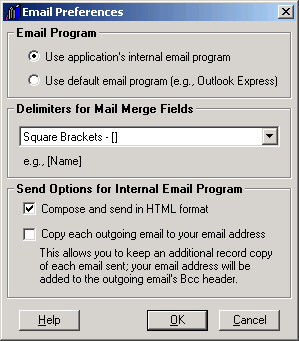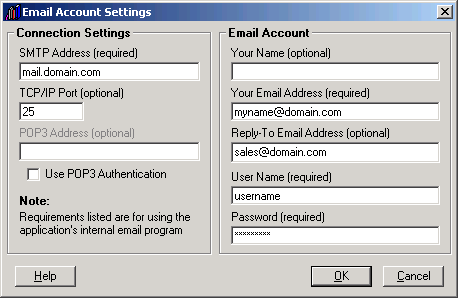
Libraries Directory Home • Online Guide • A to Z
 |
The Libraries Directory 50th Edition Libraries Directory Home • Online Guide • A to Z |
Email Preferences • Account Settings
In order to use the Libraries Directory application's email mail merge facilities, you will need to specify a number of settings and preferences:
To select the email program to use for your mailing, and to set other preferences, click on Email Preferences in the File menu of the Email Mail Merge window. This will open the Email Preferences dialog:

You can choose between two main options for composing and sending your emails:
| 1. |
You can choose to use the application's internal email program, which allows you to send messages as plain text or in HTML format, to include attachments, to set the message priority (Low, Normal or High) and to include a read-receipt request. |
|
|---|---|---|
| 2. | Alternatively, you can choose to send your messages via your computer's default email program. This is a more limited option, intended mainly as a back-up facility for the internal program. It allows you to send messages with or without attachments, but messages can only be sent as plain text, and it is not possible to set the message priority or the read-receipt request option. |
If you have chosen to use the application's internal email program, then you can set two additional options:
| 3. |
You can choose to compose and send emails in HTML format or as plain text. The default setting for the internal email program is HTML format, which allows you to include text and layout formatting, fully formatted links and images in your emails. |
|
|---|---|---|
| 4. | You can choose to copy outgoing emails to your own email address (i.e., the sender's address specified in the Email Account Settings dialog). This will automatically add the address to the Bcc (hidden recipients) field of outgoing emails, allowing you to keep copies of sent emails for record-keeping purposes. If you are sending a large mailing, you may find it useful to set up a message rule in your own email program so that when you receive the copied emails, they are automatically moved to a specific folder, rather than going directly to your main Inbox. To define a message rule that will catch the incoming copies, try specifying emails where the From field contains your own email address, or where the Subject field is the same as the subject text of your mailing. |
Additionally, the Email Preferences dialog allows you to set the field delimiters for mail merge fields. Mail merge fields are inserted into your message template as text, using delimiters which will allow the application to identify them as mail merge fields. The options available are:
Square brackets (default) - e.g., [Title]
Curly brackets - e.g., {Title}
Text - e.g., INSERT_Title_HERE
Use whichever option you find most distinctive, or which is least likely to use characters that you need to include elsewhere in your message. For example, if the text of your message uses square brackets in some other context, then use curly brackets or the INSERT text as your delimiter.
Before you can send an email mail merge, you will need to enter some or all of your email account settings in the Email Account Settings dialog. To open the dialog, click on Email Account Settings in the File menu of the Email Mail Merge window:

The required settings will be the same as those that you would enter when setting up an email account in a normal email program:
| 1. |
SMTP Address - Required only if using the application's internal email program. SMTP is the protocol used to connect to your mail server so that you can send email messages. You should enter either the SMTP host name (which will normally be something like smtp.domain.com or mail.domain.com) or you should enter the IP address to which the host name corresponds (this consists of four numbers between 0 and 255, separated by full stops, e.g., 12.123.123.4). |
|
|---|---|---|
| 2. |
TCP/IP Port - Required only if using the application's internal email program. This is number of the port used to establish a connection to your mail server. Normally you will use the default port, which is 25. However, if you need to use a different port (for example, if your computer has security measures such as a firewall installed), then you may enter the new port number here. It is recommended that you do not change this setting unless absolutely necessary. |
|
| 3. |
POP3 Address - Required only if using the application's internal email program and your email server requires POP3 authentication. To enable POP3 authentication, tick the Use POP3 Authentication check-box and enter the POP3 host name (e.g., pop3.domain.com) or IP address. |
|
| 4. |
Your Name - Optional. This is your name as it will appear in the From field in the recipient's email program. |
|
| 5. |
Your Email Address - Required only if using the application's internal email program. This will be the sender's email address for your mailing. |
|
| 6. |
Reply-To Email Address - Optional; applies only if using the application's internal email program. If you wish the recipient to reply to an email address other than the sender's address, then enter the reply address here. If you leave this blank, then the sender's address will be used for replies by default. |
|
| 7. |
User Name - Required if using the application's internal email program; may be required if using your default email program. This is the login user name for your email account. |
|
| 8. | Password - Required if using the application's internal email program; may be required if using your default email program. This is the login password for your email account. |
N.B. Whether any given setting is required or optional will depend on which email program you have chosen to use in the Email Preferences dialog. For the application's internal email program, you will need to enter the SMTP Address, your email address, your user name and password. To use your computer's default email program, only your user name and password may be required. If you are likely to be switching between the two programs, then you should enter all the settings required for the application's internal program.
See Also

About the CD-ROM
Creating and Managing Mailing Lists
Performing an Email Mail Merge
The Email Mail Merge Window
James Clarke and Co Ltd
PO Box 60, Cambridge, CB1 2NT, England
Tel: +44 (0) 1223 350865 Fax: +44 (0) 1223 366951
email: publishing@jamesclarke.co.uk